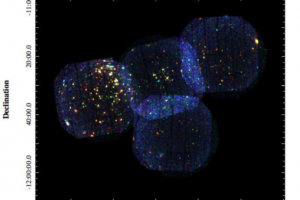Star formation history in Canis Major. Recently published by A&A “Star formation history of Canis Major OB1” of T. Santos-Silva

Stars in several star forming regions are observed with a spread in age. This support the idea that star formation is a “slow” process which can propagate across a molecular cloud over million of years (as suggested, for instance, by the Palla & Stahler 2000 study), while several authors have instead suggested that star formation is a “fast” process (e.g. Dib et al. 2010).
The study of the star formation history in a molecular cloud requires a precise identification of stars formed into the cloud, and determination of their age and motion. Even if this is typically very difficult to achieve, we have understood that several processes can induce and propagate star formation across a cloud, such as the UV radiation emitted by large population of massive stars, supernovae explosions, or the dynamic of clouds themselves.
The study “Star formation history of Canis Major OB1. II. A bimodal X-ray population revealed by XMM-Newton” of T. Santos-Silva (Universidade de São Paulo and Institut d’Astrophysique de Paris) have analyzed the star formation process in the OB association “Canis Major OB1”. Thanks to recent X-ray observations from XMM/Newton and the fact that young pre-main sequence stars are order of magnitudes brighter in X-rays than old main sequence and giant stars, the authors of this study have identified more than 300 stars formed in this region. Their age has been determined using infrared photometry in JHK bands from 2MASS. With this approach, they have found that 80% of the candidate members of Canis Major OB1 have an age of 5 Myrs or 10 Myrs, while the remainder 20% has an age between these two values. This bimodal age distribution suggests that star formation occurred in Canis Major OB1 in two major events, 5 and 10 Myrs ago. The astronomer Beate Stelzer of the Astronomical Observatory of Palermo is coauthor of this study.
The figure (link) shows the XMM-Newton observations analyzed in this study.
